Over the years we have grown a wide range of edible staple roots, both tropical and temperate.
Thus far, we’ve cultivated the following yam species:
Air potato yam (D. bulbifera)
Chinese yam (D. polystachya)
Fiveleaf yam (D. pentaphylla)
Greater yam (D. alata)
Lesser yam (D. esculenta)
Name yam (D. cayenensis subsp. rotundata)
And we’ve grown:
Arrowroot
Canna
Carrot
Cassava (Yuca)
Celeriac
Daikon
Eddoes
Groundnut (Apios americana)
Jerusalem artichoke
Jicama
Parsnip
Potato
Potato mint
Rutabaga
Sweet potato
Tannia
Taro
Turnip
Yacon
…and a few more I’m sure I’ve missed.
Yet the other day, I found a root that stumped me.
We were traveling home from our new baby’s baptism when I stopped for a minute at the Saigon Market market in Pensacola to see if they had any different sugarcane varieties for sale. There, I found a bin of strange roots, and bought four of them:
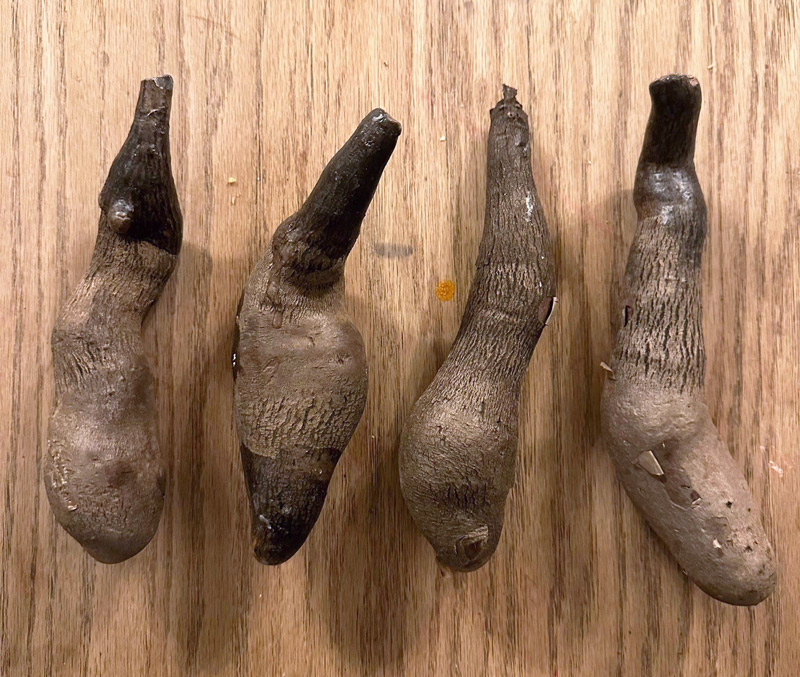
These strange little things are only about 8″ in length.
Judging by the skins, they were a true yam (Dioscorea species). Yet I had never seen any this size and shape, with skins devoid of hairy roots.
This is what a purple ube yam looks like:
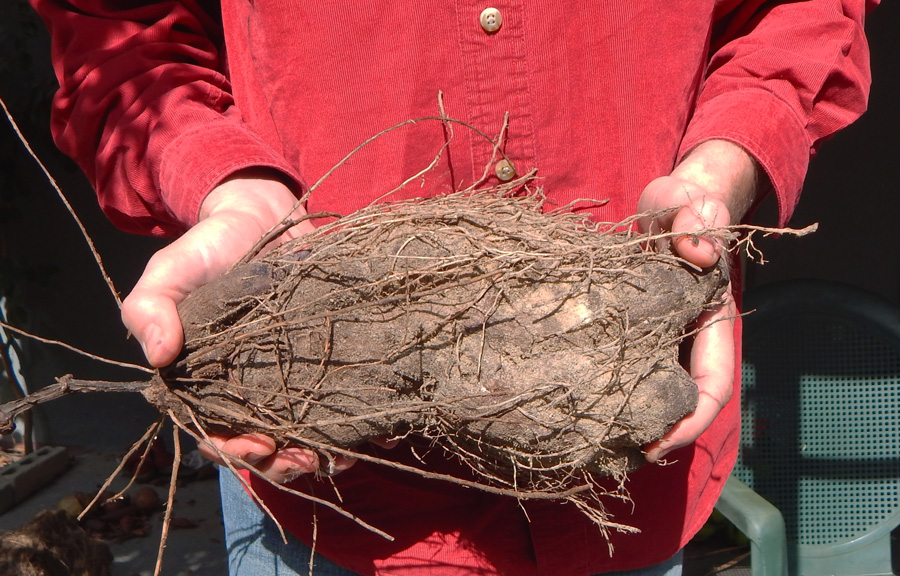
And these are lesser yams:
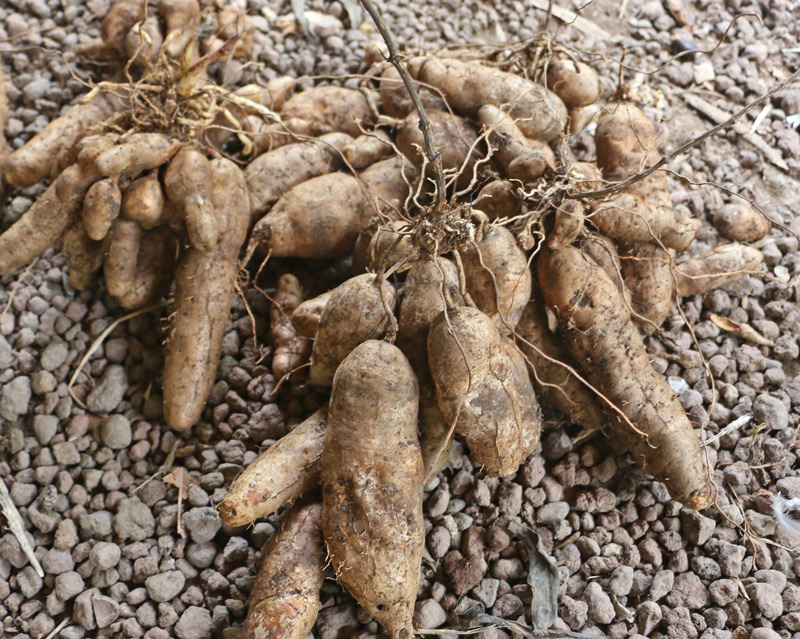
And the other yams I’ve seen and grown also don’t look like them. They’re either shaped differently, or are much larger, or have a different color, or have lots of hairy roots on their sides.
I tried using my favorite Plant ID website and it claimed they were tamarind or possibly “stinking toe”:
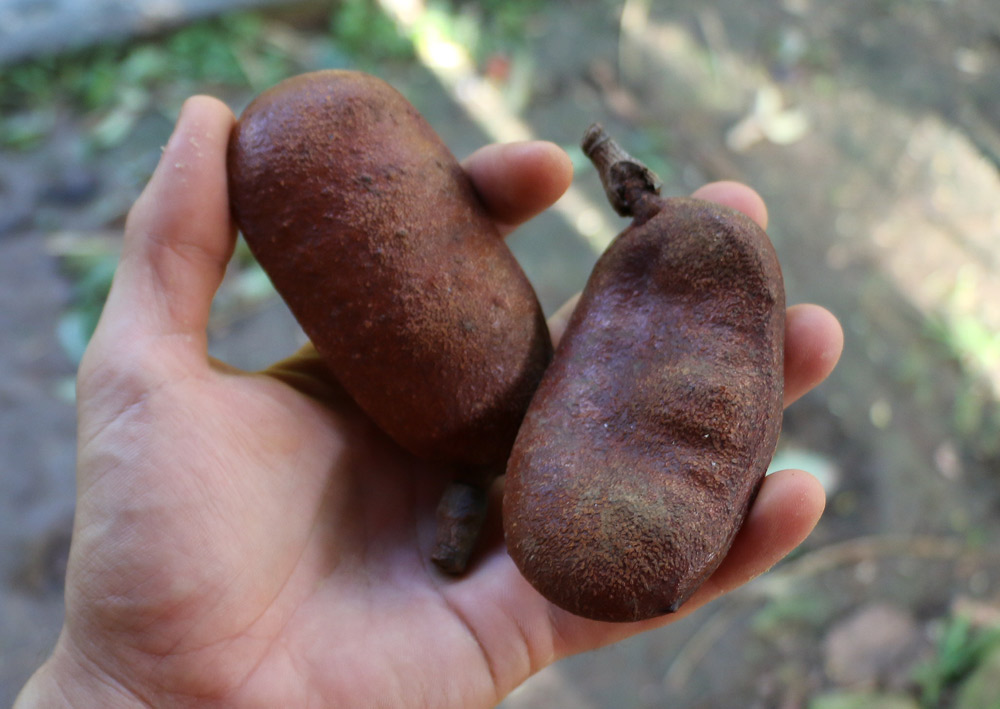
Nope, that’s not it. And it’s a crazy guess, since both tamarind and stinking toe (West Indian locust) are legume tree pods. You can’t always trust Plant ID apps, though they are a good place to start.
When the plant ID site failed, I then performed a reverse image search and got some fascinating results:

Ah-ha! It’s a spinosaur tooth! That’s it!
No, that can’t be right either. Why would they sell fossil teeth in the produce section instead of near the denture adhesive?
Since I wasn’t having any luck on my own, I put the picture up in a YouTube post and asked for help with identification.
There were a lot of guesses, with some commenters claiming they were a type of sweet potato, or a type of yam I already knew, or a variety of cassava.
However, sweet potatoes look like this:

Yet sweet potato skins do not have that gray-brown wrinkly texture in any cultivar I’ve ever seen.
And the skin of cassava root definitely doesn’t look like the roots I found, as its coarser and usually reddish-brown:
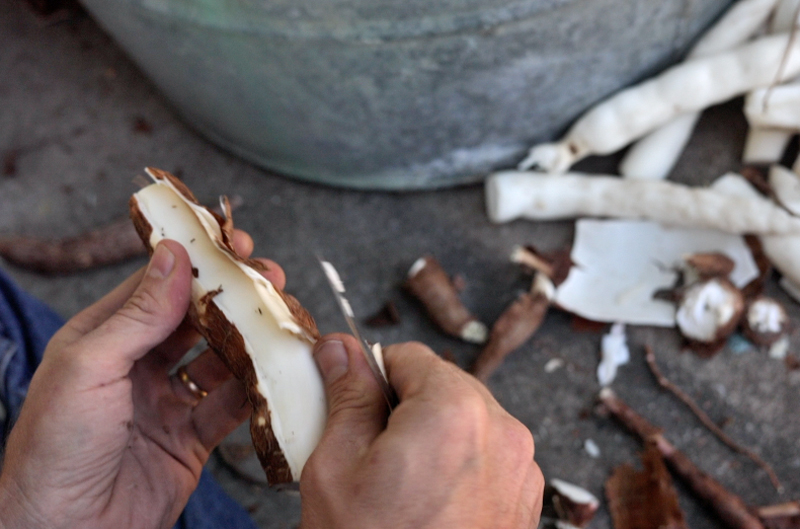
Another person guessed it was taro, but taro looks like this:
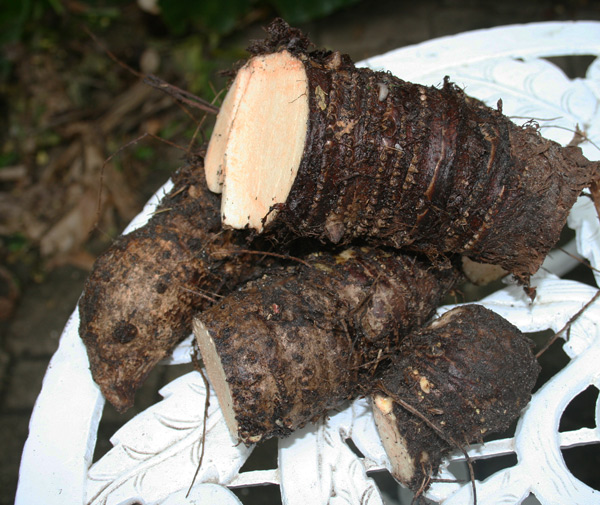
Nope, definitely not taro.
And then, we got a winner on the guesses!

After doing a quick search for Dioscorea trifida, neferacroom3273 was confirmed correct. Thank you! We had our root!
According to Plants for a Future’s write up on Dioscorea trifida:
“Cush cush yam is a perennial climbing plant producing twining stems about 3 metres long from a tuberous rootstock. These stems scramble over the ground, or twine into the surrounding vegetation. The plant is widely cultivated in tropical areas, especially S. America and the Caribbean, for its edible root.”
Once I had the name cush cush, I remembered my neighbor Derek in Grenada telling me cush cush was a very good yam variety “from the earlies,” (meaning “the old days) but wasn’t so common on the island anymore. In fact, my Grenadian friend Mike once gave me a piece of it to grow when we first moved to the island, though I lost the plant when we later moved to our apartment. The leaves on that vine were different from other yam leaves, as you can see on the PFAF page linked above, and I never really got a good look at an entire root.
As James M. Stevens at UF writes:
“Cushcush is one of the lesser known cultivated species of tropical yam. Other common names are yampi (Jamaica), aja (Cuba), maona (Peru), mapuey (Puerto Rico), and cara doce (Brazil). Cushcush is native to the Caribbean where it is known as the best of the yams because of its flavor and cooking qualities.
In general, yams have never become as important a staple food in the Americas as they have in Africa, Asia, and the Pacific Islands because the same food purposes are served by sweet potatoes, cassava, and coco-yams. Cushcush is used throughout South America, Trinidad, and the West Indies, but not as a staple owing to the presence of cassava. It is highly probable that cushcush could be grown in Florida, but at present it is rarely grown or recognized by gardeners. Vines of other Dioscorea species are grown as ornamentals that do well in North and South Florida.”
He further writes:
“Cushcush, like other tropical yams, is perennial, surviving adverse seasons via the tubers. It is best produced as an annual planted early in the spring and harvested 10 to 11 months later. It is a warm season crop and does not tolerate below freezing temperatures.Growing cushcush is similar to growing potatoes, except for trellising. Plant small, whole tubers or large tubers cut into 2-ounce pieces. Pieces taken from the upper portion of the tuber have more eyes and produce more stems and tubers than do seedpieces taken lower on the tuber. Because of the vining habit of the plants, stakes 6 to 9 feet in length are used. Weak stakes and poorly supported trellises will be pulled down by the vigorous vines.
Harvest of tubers follows planting by about 10 to 11 months in climatic areas similar to South Florida. The foliage dies back when tubers are about ready to be dug. Spade or fork them out of the soil much as you would potatoes. Yields of cushcush tend to be much lower than for other forms of yam, such as D. alata. The tubers, which contain 7% protein and 38% starch, may be baked whole or peeled and cut for boiling.”
If 10-11 months of growing is truly required, it’s a bit cold here to grow cush cush; however, we’re obviously going to try it anyhow.
There are some good pictures of the roots at this website, where they also offer cush cush roots for purchase.
We’ll have to try growing some in the garden and some in the greenhouse. I have no idea whether or not they’ll sprout quickly or wait for months before emerging, so I’m going to put some in well-drained soil in the greenhouse to see what happens. I’ll let you know if they grow.
Thank you all for the help on YT guesses – I’m very glad we were able to pin down the exact species. If you live in South Florida or a similar non-freezing climate, this could be a good addition to your list of survival root crops. If you get roots, try and see and let me know how you do!


5 comments
I had this species at one point but it didn’t survive the winter. There’s a guy named Ceasar on the tropical fruit forum that grows tons of rare yams. Hard to get ahold of him these days though. I’ve sent a few messages with no response yet. Worth a try either way. Also some other unusual root crops like leren. Some really cool stuff like siagon purple dioscorea bulbifera, rotundata, dodecaneura, 3 other types of edible bulbifera, etc.
I’ll plant it in the greenhouse and see if it lives. Thank you. How are you feeling?
Feeling much better than that first day. The pounding headache was unbearable. Couldn’t hardly move. Fortunately the Lord removed that by that evening after the previous night and day suffering like crazy. Was pounding so hard the skin and flesh on my forehead and my eyes felt bruised the next day. However the headache had subsided. Cv started off that same way before but fortunately I don’t think it’s that again. Threw everything I had at this the first day and haven’t yet up since. Tons of herbal teas with roselle, turmeric, ginger, etc; pasted up turmeric, ginger, black pepper, raw cocao, coconut oil, etc in large doses trying to get that anti-inflammatory effect; honey fermented elderberry, honey fermented garlic and ginger, salt water gargle, fresh lemon juice and honey, iodine supplement, and elderberry flower tincture multiple times a day. Wasn’t playing around with this. The cv got real bad when I had it in July 2021. Thought I was gonna die. Part of it was 3 days gasping for air praying a crying for it to stop. Was a 2 week ordeal altogether. Didn’t have the horse stuff at that time or I would have tried it in desperation. I’m more afraid of the hospital though so I was prepared to die at the house versus going there. My boss at that time had the same situation in which he went to the hospital but they just sent him home saying they couldn’t do anything. His cousin is a vet and dosed him with the horse stuff that day and he literally cleared up overnight. Since then I obtained some myself just in case I absolutely had to use it if faced with a similar problem in the future. Had the “long cv” symptoms for well over a year afterwards. My wife getting a racing heart and me having 15 min bursts of feeling like I couldn’t breathe 2-3 times a day. Heard nicotine displaces the proteins from receptor sites so gave that a try. Totally works. Symptoms faded immediately and haven’t returned since. Definitely another reason to grow lots of tobacco! Pretty much used the same herbal regime when I was sick with cv with the addition of chaga tea. I think if I hadn’t of had all that I may have died. Seemed like elderberry in paticular pushed back the symptoms significantly.
Anyways sorry for the lengthy response but maybe someone can benefit from my personal experience. Thanks for your prayers as well! When things had gotten pretty financially tight and I had asked for prayers before I had a huge influx of financial relief pour in a day or two later. It was definitely uncanny that the Lord had responded. He’s always there when you need it and things are getting dire.
For those interested (I am!) here are some additional resources from ECHO Global in N. Fort Myers, FL (also you can search at echocommunity.org):
https://assets.echocommunity.org/publication_issue/f83fcb08-d03d-4fd4-8519-49810e394cf4/en/tropical-yams-and-their-potential-part-5-dioscorea-trifida.pdf
https://assets-global.echocommunity.org/pdf/FPI/PFS/Dioscorea+trifida.PDF
The paper is a 30-pager from 1978 about everything you could want to know–and there are 11 varieties?! Now I really want to grow this yam!
My sister brought me six ube yams from FL last spring. I started them in pots in my greenhouse. I sold two. Planted two in beds in the greenhouse and left two in pots in the greenhouse.
When the two in the pots started pushing out because the yam was that big I harvested them. But I don’t know anything about how to prepare them to eat.
Can you point me in the right direction on YouTube or otherwise? Just a detailed recipe would help.
Oh I left the two in the bed for another year.
I will probably eat one of the harvested ones and cut the other for starters for the next year.
Comments are closed.